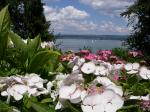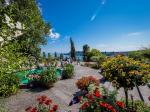
- A journey through time
-
Gardens
- Mainau Island
- Island of Reichenau
- Castle and Park Arenenberg
- Unlimited Garden-Rendezvous on the western Lake Constance
- Charterhouse Ittingen
- Salem Palace
- Fürstenhäusle Meersburg
- Augustinum Meersburg
- Bible garden Bible gallery Meersburg
- Meersburg New Palace
- Garden culture path Überlingen
- Wartegg Castle
- Sculpture garden FORUM WÜRTH RORSCHACH
- Garden Canton Thurgau
- A.Vogel World of Natural Remedies
- Archeobotanical Garden Frauenfeld
- Seeburgpark Kreuzlingen
- Lilienberg Ermatingen
- VitaPlant AG - Medicinal plant garden
- Hafterpark Weinfelden
- Ceres Heilpflanzengarten Kesswil
- Rosenstadt Bischofszell
- Klostergarten St.Gallen
- City garden Singen
- Garden dreams Bregenz
- Kräuter Schopf Appenzell
- Bible garden Gossau
- Schlösslepark Kressbronn
- Hofgarten Schloss Messkirch
- Stadtgarten Stockach
- Schloss Freudental
- Foundation Napoleon III
- Uferpromenade Langenargen
- Gartenparadiese Wangen im Allgäu
- Nutrition field Vaduz
- Herb garden Mauren
- Stein Egerta Schaan
- Gartenpfad Osterfingen
- Island of Reichenau
- Schaugarten der Biogärtnerei Neubauer
- Staudengärtnerei Gaissmayer Illertissen
- REGENA AG - Medicinal herb garden
- Map
- Long night
- Nature in the garden
- Service and Contact
- Home
- A journey through time
- A Compass through the Eras
- Lake Dwellers, Celts and Romans (12.000 BC till AD 400)
Lake Dwellers, Celts and Romans (12.000 BC till AD 400)
From the Lake Dwellings to Villa Rustica
Anyone who thinks that the archaeologists would know nothing of the garden passion of our Stone Age ancestors is mistaken. Perhaps it is presumptuous to speak from "passion", but horticulture exists verifiable since 12.000 BC.
Ingredients of the Lake Dwellers kitchen
Very close to the famous Lake Dwellings were fields with fences for the protection against wild pigs. On these fields grew grain or peas. In addition they cultivated in a simple way crop plant, e.g. corn poppy, blackthorn or hazelnut. Apples, acorns, wild strawberries and bear's garlic were as well a part of the assortment of a "Lake Dweller-Garden".In the garden of the Nature Museum and the Museums of Archaeology of the canton Thurgau (both CH-Frauenfeld) as well as in the archaeobotanical garden (D-Hemmenhofen) you can get to know many of these original crop plants.
The Romans foster the first flower gardens
In the following centuries became the primarily compulsion for horticulture a strong growing passion. Around 50 AD came the Romans at the Lake Constance and taught the native Celts, how to cultivate a garden properly and to use the garden also for relaxation and representation. The Romans knew basically two types of gardens: the garden courtyard of a town house and the gardens of their country estate. In the city belonged a walled area as a kitchen garden as well to the construction as a garden courtyard, which was as flower garden connected with the living quarters. At his country estate owned the neat Roman - depending on his wealth - large and small formal designed pleasure gardens with arbours and bathing facilities. Of course played wine and vines an important role.
Findings in the area
Although it gave around the Lake Constance a number of ancient forts with civilian settlements (e.g. Constance, Pfyn, Bregenz, Arbon), it seems that no example of a town house with garden has been preserved. But country estates, so-called "villae rusticae", can be proved more often. A particular beautiful example can be found in Hüttwilen-Stutheien (CH), half way between Untersee (German for Lower Lake) and the Thurtal. The Thurgauer cantons-archaeology discovers constantly sensational findings. The finest pieces can be admired in the Museum for Archaeology in Canton Thurgau (Frauenfeld). Also worth seeing is the Archaeology State Museum Baden-Württemberg in Constance.




 deutsch
deutsch







